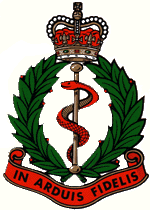225th (Parachute) Field Ambulance
| 225th (Parachute) Field Ambulance | |
|---|---|

|
|
| Active | 1943–1946 |
| Country | United Kingdom |
| Branch | British Army |
| Type | Medical |
| Role | Airborne forces |
| Size | Field Ambulance |
| Part of | 5th Parachute Brigade |
| Engagements |
Operation Tonga Operation Varsity Operation Tiderace |
| Insignia | |
| Emblem of the British Airborne Forces |
 |
The 225th (Parachute) Field Ambulance was a Royal Army Medical Corps unit of the British airborne forces during the Second World War.
When raised the Field Ambulance was assigned to the 5th Parachute Brigade, which was part of the 6th Airborne Division. As such they participated in Operation Tonga part of the Normandy landings. The unit remained in France until September 1944, when they were withdrawn back to England to rest and rebuild. They then took part in the last and largest airborne mission in the war, Operation Varsity, the River Rhine crossing in 1945.
After the war in Europe ended they were sent to the Far East for operations against the Japanese however the war ended before they could be deployed. Instead they were sent to Malaya and Singapore to assist in the restoration of British control. Later in the year they were sent to Java, where the brigade had to maintain law and order until a Dutch force could arrive to relieve them. The Field Ambulance then returned to Singapore, for a short time before leaving to rejoin the 6th Airborne Division, now serving in Palestine. However shortly after arriving the 225th (Parachute) Field Ambulance was disbanded.
Impressed by the success of German airborne operations, during the Battle of France, the British Prime Minister, Winston Churchill, directed the War Office to investigate the possibility of creating a corps of 5,000 parachute troops. In September 1941 the 1st Parachute Brigade began forming, comprising three parachute infantry battalions. In keeping with British Army practice at the same time as the infantry battalions were forming, airborne supporting arms were formed including Royal Army Medical Corps volunteers. Of the seven airborne field ambulances formed during the Second World War, two, the 181st and the 195th, were glider borne, while the other five, the 16th, 127th, 133rd, 224th and the 225th, were parachute trained.
...
Wikipedia
